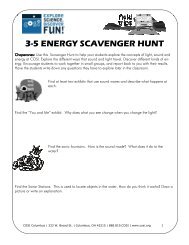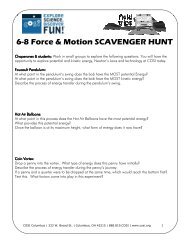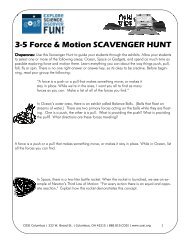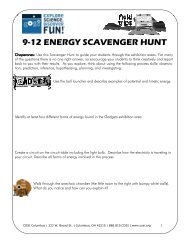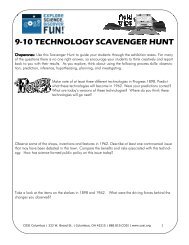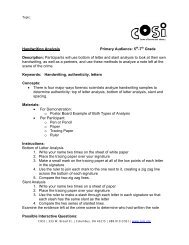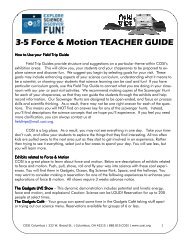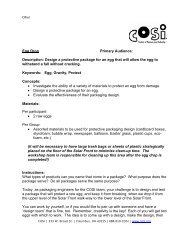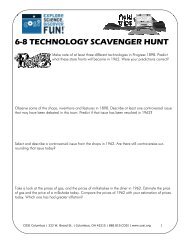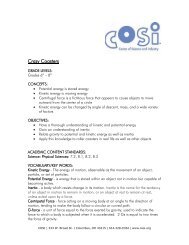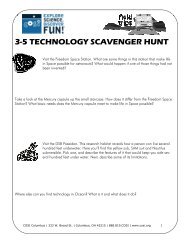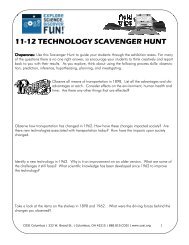Running on Empty Primary Audience: Middle School ... - COSI
Running on Empty Primary Audience: Middle School ... - COSI
Running on Empty Primary Audience: Middle School ... - COSI
- No tags were found...
Create successful ePaper yourself
Turn your PDF publications into a flip-book with our unique Google optimized e-Paper software.
Topic<str<strong>on</strong>g>Running</str<strong>on</strong>g> <strong>on</strong> <strong>Empty</strong><strong>Primary</strong> <strong>Audience</strong>: <strong>Middle</strong> <strong>School</strong>Descripti<strong>on</strong>: Students will learn that food is the fuel that powers them to have funduring their recess time while also learning that exercise is fun and active fun isexercise.Keywords: Calorie, Nutriti<strong>on</strong>, EnergyMaterials: Poster board Marker Calculators Student worksheets ScaleInstructi<strong>on</strong>s:1. At the beginning of the week create a chart <strong>on</strong> poster board with the students’ namesacross the side and the recess periods across the top.2. At the beginning of the week distribute worksheets to students.3. Allow students to weigh themselves (discreetly) and record their weight so as toprovide accurate readings.4. After each recess period have the students use the worksheets to figure out howmany calories they burned during that period.5. Chart how many calories the students burned and tabulate at the end of the week.Possible Interactive Questi<strong>on</strong>s: See how many calories each of the students’ favorite foods has and how l<strong>on</strong>gthat would power each student.What’s Going On?Our bodies need fuel to do everything; walking, running, jumping, even things assimple as breathing! The fuel our bodies use is called calories and we obtain them fromeating food. By eating healthy, nutrient-rich foods, our bodies become properly fueled todo the activities that we love to do every day. The bigger a pers<strong>on</strong> is, the more caloriestheir body burns. The more active we are, the better our bodies burn calories.<strong>COSI</strong> | 333 W. Broad St. | Columbus, OH 43215 | 888.819.<strong>COSI</strong> | www.cosi.org
TopicRelevant Ohio Science C<strong>on</strong>tent Standards:Life Sciences K-2 A: Discover that there are living things, n<strong>on</strong>-living things and pretend things,and describe the basic needs of living things (organisms).o 1.1: Explore that organisms, including people, have basic needs whichinclude air, water, food, living space and shelter.o 2.1: Explain that animals, including people, need air, water, food, livingspace and shelter; plants need air, water, nutrients (e.g., minerals), livingspace and light to survive.o 2.5: Explain that food is a basic need of plants and animals (e.g., plantsneed sunlight to make food and to grow, animals eat plants and/or otheranimals for food, food chain) and is important because it is a source ofenergy (e.g., energy used to play, ride bicycles, read, etc.).Scientific Inquiry K-2 B: Design and c<strong>on</strong>duct a simple investigati<strong>on</strong> to explore a questi<strong>on</strong>.o 2.7: Use appropriate tools and simple equipment/instruments to safelygather scientific data (e.g., magnifiers, n<strong>on</strong>-breakable thermometers,timers, rulers, balances and calculators and other appropriate tools). 3-5 B: Organize and evaluate observati<strong>on</strong>s, measurements and other data toformulate inferences and c<strong>on</strong>clusi<strong>on</strong>s.o 3.3: Read and interpret simple tables and graphs produced by self/others.o 3.5: Record and organize observati<strong>on</strong>s (e.g., journals, charts and tables). 3-5 C: Develop, design and safely c<strong>on</strong>duct scientific investigati<strong>on</strong>s andcommunicate the results.o 4.5: Describe how comparis<strong>on</strong>s may not be fair when some c<strong>on</strong>diti<strong>on</strong>s arenot kept the same between experiments.Scientific Ways of Knowing 3-5 C: Explain the importance of keeping records of observati<strong>on</strong>s andinvestigati<strong>on</strong>s that are accurate and understandable.o 4.2: Record the results and data from an investigati<strong>on</strong> and make areas<strong>on</strong>able explanati<strong>on</strong>.o 4.4: Explain why keeping records of observati<strong>on</strong>s and investigati<strong>on</strong>s isimportant.<strong>COSI</strong> | 333 W. Broad St. | Columbus, OH 43215 | 888.819.<strong>COSI</strong> | www.cosi.org



